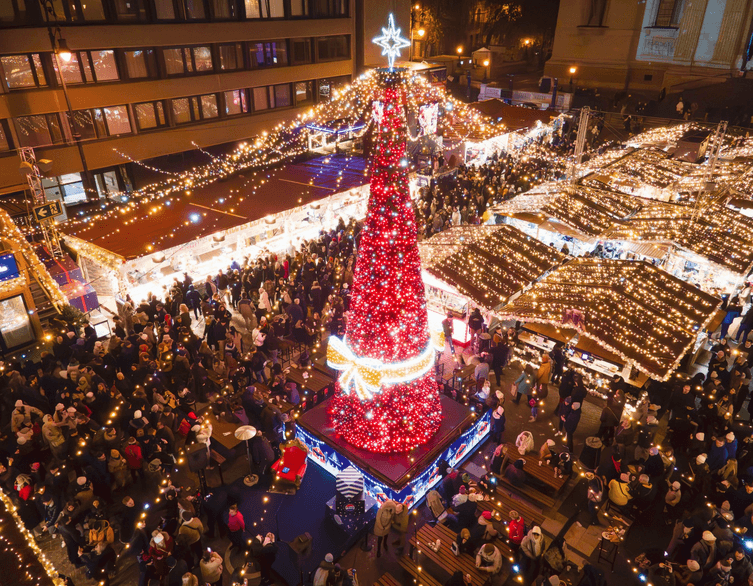Budapest Christmas Markets 2025: A Complete Guide to Prices and Traditional Foods

Budapest’s Christmas markets have opened for the 2025 season, and if you’re planning to visit, you’re probably wondering what foods to try and how much you’ll need to budget. The good news is that the Vörösmarty Classic Xmas on Vörösmarty Square and the Advent Bazilika at St. Stephen’s Basilica have maintained their commitment to affordable pricing while offering an impressive array of traditional Hungarian dishes and international specialties.
The Budget-Friendly Fixed Price Menu
The smartest money-saving secret at Budapest’s Christmas markets is the 1,600-forint fixed-price menu available at every major food stall. While vendors don’t always advertise this option prominently, you can ask for it at any large kitchen booth across both markets. This tradition continues from previous years, ensuring that everyone can enjoy authentic Hungarian Christmas market food without breaking the bank.
Beyond the fixed menu, the organizers have established maximum prices for several staple items to keep the markets accessible. This means you can enjoy classic Christmas market treats at standardized rates across different vendors, making it easier to budget your visit.
Classic Hungarian Dishes and Their Prices
Lángos: The Hungarian Fried Bread
No visit to a Hungarian Christmas market would be complete without trying lángos, the iconic deep-fried flatbread that locals consider essential street food. A plain lángos starts at 2,400 forints at the Basilica market and around 2,500 forints at Vörösmarty Square. The traditional version topped with sour cream and cheese costs 3,200 forints, while more elaborate versions with bacon can reach 4,500 forints. For adventurers seeking fusion flavors, the Dubai chocolate lángos represents one of this year’s creative innovations, though it commands a premium price.
The beauty of lángos lies in its simplicity. The dough is fried until golden and crispy on the outside while remaining soft and pillowy inside. The classic preparation involves rubbing the hot bread with garlic before adding dollops of sour cream and generous handfuls of shredded cheese. Some visitors prefer the garlic-rubbed version at 2,700 forints, which offers intense flavor without the dairy richness.
Gulyás: Hungary’s Famous Soup
Gulyás soup, known internationally as goulash, ranks among Hungary’s most famous culinary exports. This hearty soup combines beef, vegetables like peppers and tomatoes, potatoes, onions, and generous amounts of paprika to create a thick, warming dish perfect for cold winter days. At the Christmas markets, a bowl of gulyás costs between 4,000 and 4,850 forints depending on the vendor and preparation style.
One of the most photogenic presentations involves serving the soup in a hollowed-out bread bowl at 5,700 forints. This edible vessel not only keeps the soup hot longer but also adds another layer of deliciousness when you tear off pieces of the bread soaked in the flavorful broth. The soup itself is substantial enough to serve as a complete meal, making it excellent value for money.
Best deals of Budapest
Töltött Káposzta: Festive Stuffed Cabbage
Stuffed cabbage represents one of Hungary’s essential Christmas dishes, traditionally served during holiday celebrations. The dish consists of cabbage leaves wrapped around a filling of ground pork and rice, then slow-cooked in a tomato-paprika sauce. At the markets, a portion with two cabbage rolls costs between 5,700 and 6,700 forints, typically served with a generous dollop of sour cream and fresh bread for soaking up the sauce.
The stuffed cabbage embodies Hungarian comfort food at its finest. The slightly tangy cabbage mellows during cooking while the filling becomes tender and flavorful. The sauce, enriched with paprika and sometimes bacon, ties everything together with the kind of deep, satisfying flavor that makes you understand why Hungarians serve this dish at their most important celebrations.
Pörkölt and Other Stews
Beef pörkölt, a Hungarian stew similar to but distinct from gulyás, costs around 6,500 forints for a hearty portion. This dish features more meat and less liquid than gulyás soup, with the beef cooked until fork-tender in a rich paprika sauce. The stew is typically served with nokedli, small Hungarian dumplings that catch the flavorful sauce.
More adventurous offerings include pork knuckle prepared in traditional style at 6,700 to 6,800 forints, and various grilled meats that showcase Hungarian cooking techniques. Roasted goose legs, sausages grilled over open flames, and barbecued pork ribs all make regular appearances on market menus, with prices ranging from 5,500 forints for simple grilled sausages with bread and mustard to 8,300 forints for a thirty-centimeter barbecue spare rib.
Fish Specialties
For those seeking lighter options, several vendors offer fish dishes that reflect Hungary’s freshwater fishing traditions. Smoked salmon plates cost between 7,280 and 9,500 forints, representing the higher end of market pricing. More traditional preparations include halászlé, a spicy fisherman’s soup made with multiple types of freshwater fish like carp, perch, and pike-perch, all seasoned with copious amounts of paprika.
Sweet Treats and Desserts
Kürtőskalács: The Chimney Cake
Kürtőskalács, known in English as chimney cake, has become synonymous with Hungarian Christmas markets. This traditional pastry from Transylvania consists of sweet yeast dough wrapped around a wooden spit, rolled in sugar, and baked over hot coals until golden and caramelized. The rotating cooking method creates a crispy, caramelized exterior while keeping the interior soft and slightly chewy.
Traditional flavors including vanilla, cinnamon, walnut, cocoa, and coconut typically cost between 2,800 and 3,900 forints. The coal-baking method imparts a subtle smoky essence that makes these chimney cakes special compared to versions baked in conventional ovens. Watching them being made over the glowing coals adds to the sensory experience, with the sweet aroma of caramelizing sugar drawing crowds to the kürtőskalács stands.
More elaborate versions incorporate Nutella or other chocolate spreads, with Nutella-filled churros priced at 3,500 forints and Nutella crepes at 3,200 forints. Some vendors offer to fill the hollow center of the chimney cake with ice cream, whipped cream, or Nutella for an extra-decadent treat.
Bejgli: Traditional Christmas Rolls
Bejgli represents the quintessential Hungarian Christmas dessert. These rolled pastries come in two traditional varieties: walnut filling or poppy seed filling. The flaky pastry encases generous amounts of sweetened, spiced nuts or poppy seeds, creating a dense, rich dessert traditionally sliced thin and served with coffee. At the markets, you’ll find bejgli slices around 1,900 forints, or you can purchase whole rolls to take home.
Other Sweet Options
Rétes, Hungarian strudel filled with apple, cherry, or cheese, sells for approximately 1,900 forints per slice. The paper-thin pastry layers encase fruit or cheese fillings that range from tart to sweet. Roasted chestnuts, sold in paper cones for 2,800 forints, provide a simple, warming snack perfect for munching while browsing the market stalls.
Beverages to Warm Your Winter
Forralt Bor: The Essential Mulled Wine
Perhaps the most democratic pricing at the Christmas markets applies to forralt bor, Hungarian mulled wine. Every hot drink stand at both markets serves the classic, unflavored version for exactly 1,500 forints. This standardized pricing eliminates any need to comparison shop between stalls, letting you grab a cup wherever you happen to be standing when the cold sets in.
The Hungarian version of mulled wine emphasizes the natural flavors of red wine enhanced with warming spices like cinnamon, cloves, and star anise, along with citrus peel and a touch of sugar. Unlike some Western European versions that can taste syrupy, Hungarian forralt bor maintains a good balance between sweetness and the wine’s natural tannins.
Premium Hot Drinks
For those wanting something different, rum punch costs 3,700 forints and delivers a stronger alcoholic kick along with more intense spicing. Hot chocolate comes in at 2,000 forints, while alcohol-free punch provides a family-friendly warming option at 1,500 forints, matching the price of standard mulled wine.
Themed Gastronomic Weekends
One of the most exciting features for return visitors is the series of themed gastronomic weekends. Each weekend throughout the season focuses on a specific culinary theme, with participating vendors creating special dishes priced between 2,000 and 2,500 forints.
The themes rotate weekly in this order: goose dishes, pork knuckle preparations, fish specialties, sweets and desserts, various pörkölt and gulyás interpretations, different styles of stuffed cabbage, and dishes prepared with alcohol. The Advent Bazilika concludes with Lencse Nap on January 1st, when vendors serve traditional lentil dishes believed to bring prosperity for the new year. These themed weekends give food enthusiasts reasons to visit multiple times throughout the season.
Variety Beyond the Basics
While the traditional Hungarian dishes form the backbone of the food offerings, both markets feature close to three hundred different dishes representing various cuisines and cooking styles. This diversity means vegetarians can find options beyond potato pancakes, though Hungarian cuisine’s heavy emphasis on meat and dairy means plant-based choices remain limited.
Burgers appear at multiple stands, uniformly priced around 4,700 forints, with options ranging from classic beef to more adventurous choices like duck burgers at 6,700 forints. Thirty-centimeter grilled skewers cost approximately 5,200 forints, while XXL-style meat portions cater to the heartiest appetites.
The vendors pride themselves on maintaining premium street food standards with generous portions. Most stalls offer smaller portion sizes at reduced prices, making the markets accessible for children or those with lighter appetites who want to sample multiple dishes rather than committing to one large plate.
Understanding the Value
The organizers proudly note that seventy percent of food vendors kept their prices unchanged from 2024, with the remaining items seeing an average increase of only 1.5 percent. This restraint in pricing, especially during a period of broader inflation, demonstrates the markets’ commitment to remaining accessible to both Budapest residents and international visitors.
Compared to similar Christmas markets in Western European capitals where a simple sausage can easily cost the equivalent of 3,000 to 4,000 forints and mulled wine often exceeds 2,000 forints, Budapest’s markets offer exceptional value. The combination of reasonable prices and generous portions means visitors can enjoy a full culinary experience without anxiety about overspending.
The fixed-price menu at 1,600 forints and the standardized prices for staples like plain lángos, cheese-and-sour-cream lángos, grilled sausage, stuffed cabbage, and classic mulled wine create predictable costs for budget-conscious visitors. Even the more expensive items like salmon dishes remain within reasonable ranges compared to restaurant prices in Budapest or market prices elsewhere in Europe.
Budapest’s Christmas markets succeed in creating an atmosphere where the focus can remain on enjoyment rather than constant calculation. Whether you’re warming up with a cup of 1,500-forint mulled wine while sampling a slice of fresh chimney cake, settling in with a bread bowl full of steaming gulyás, or working your way through the themed weekend specialties, the combination of authentic flavors, festive atmosphere, and fair pricing makes these markets culinary destinations in their own right, not just pretty backdrops for holiday photos.
Related news
Related events

















